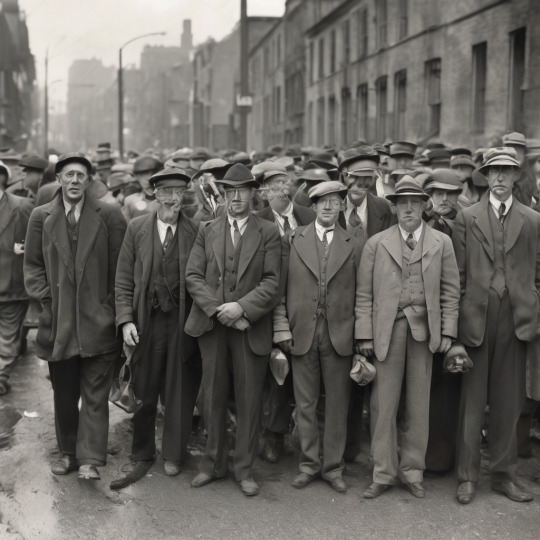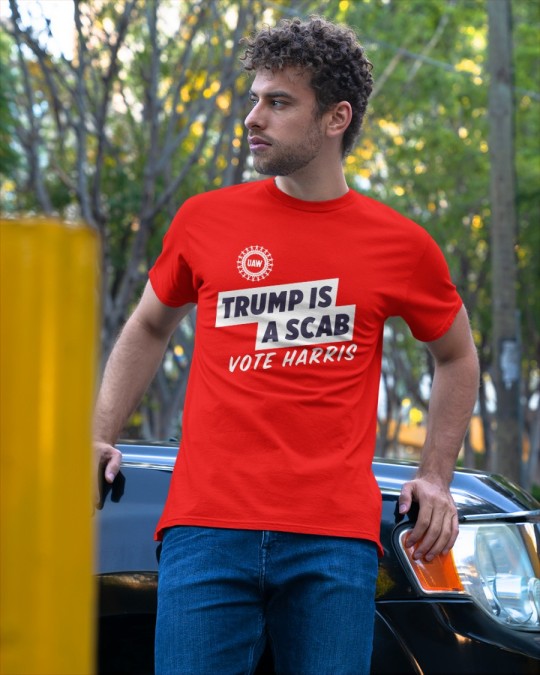#LaborMovement
Explore tagged Tumblr posts
Text
Trotskyism: Counter-revolution in Disguise, Ch. 12: The Trotskyites in the USA (1935) by M. J. Olgin. Marxist Audiobook.
youtube
#marxism#trotsky#trotskyism#marxismleninism#socialism#communism#ussr#sovietunion#socialist#communist#youtube#marxist#politics#labor#labormovement#laborstrike#laborunion#Youtube
10 notes
·
View notes
Text
Scabiversary
Today, November 20th, is the anniversary of the first use of the word “scab” in print in 1816. The term was coined 200+ years ago by the Albany Typographical Society, referring to individuals who cross a picket line while workers strike. Here's some examples of the word "scab" mentioned in our collections.



#Archives#Scabiversayr#KheelCenter#ILGWU#ILR#CornellUniversity#ILRSchool#Cornell#LborLabor#DigitalArchives#LaborHistory#Unions#LaborArchives#2024#LaborMovement#LaborRelations#Workers
9 notes
·
View notes
Text
Happy Labour Day!
The strength of a nation lies within its workforce.

#leadpac#politicalanalysisinhyderabad#telanganapolitics#politicalanalysis#politics#telangana#MayDay#LaborDay#WorkersRights#WorkersUnite#LaborMovement#May1st#InternationalWorkersDay#Solidarity#WorkersStruggle#WorkersPower#business#indian politics
5 notes
·
View notes
Text
Happy Labour Day!
Here's to celebrating hard work and dedication!

#WebLogDigi#DigitalMarketing#SocialMediaMarketing#MayDay#LaborDay#WorkersRights#WorkersUnite#LaborMovement#May1st#InternationalWorkersDay#Solidarity#WorkersStruggle#WorkersPower#business#digital marketing
2 notes
·
View notes
Text
Happy Labor Day!
We would like to take this opportunity to express my gratitude to all those who work for our nation.

#minikart#wednesday#wednesdaymood#wednesdayvibes#onlineshopping#uniquegifts#giftsomeonespecial#onlinestore#MayDay#LaborDay#WorkersRights#WorkersUnite#LaborMovement#May1st#InternationalWorkersDay#Solidarity#WorkersStruggle#WorkersPower#labour#unique gifts#gift ideas
2 notes
·
View notes
Text
Union Members! This is the perfect T-Shirts for YOU.

Union T-Shirts!

(As an Amazon Associate, I earn from qualifying purchases.)
0 notes
Link
The minimum wage debate is heating up again as the cost of living soars and workers demand fair pay! Introduced during the Great Depression, the federal minimum wage has only seen a handful of adjustments since its inception. Proponents argue that raising it could lift millions out of poverty, boost consumer spending, and enhance worker morale. But opponents warn of rising prices and potential job losses. It’s a complex tug-of-war between economic growth and fair compensation. How do we find a balance that works for everyone? Join the conversation and stay informed!
Sign Up to the free newsletter here www.investmentrarities.com.
#MinimumWage#LivingWage#EconomicDebate#WorkersRights#FairPay#CostOfLiving#PovertyReduction#ConsumerSpending#JobCreation#EconomicGrowth#LaborMovement#IncomeInequality#SocialJustice#FairWages#WorkplaceEquity#GreatDepression#FinancialLiteracy#NewsletterSignup
0 notes
Text
The Decline of Welfare Capitalism and the Rise of Collective Bargaining in HRM (1930-1940)

The Great Depression of the 1930s not only brought about significant economic challenges but also marked a critical turning point for Human Resource Management (HRM) in the United States and other industrialized nations. While the early 20th century saw the rise of welfare capitalism, which emphasized company-provided benefits and non-union personnel management programs, the 1930s dismantled many of these initiatives. The period revealed the limitations of HRM’s welfare-oriented practices and shifted the balance of power toward labor unions and collective bargaining as the preferred method of employment relations.
This essay explores the decline of welfare capitalism, the weakening of HRM's strategic influence, and the growing dominance of collective bargaining during the 1930s. It will examine the ways in which HRM lost prestige and power, and how labor unions filled the vacuum left by weakened corporate labor programs. The shift from cooperative employer-employee relations to adversarial labor-management negotiations fundamentally altered the trajectory of HRM during this period, leaving lasting effects on the field for decades to come.
The Fall of Welfare Capitalism
Welfare capitalism, a popular model in the 1920s, was based on the idea that companies could prevent labor unrest and improve employee loyalty through the provision of benefits and welfare programs. Employers offered health insurance, pensions, company housing, and recreational facilities, all in an effort to create a cooperative and loyal workforce. However, this model relied heavily on the profitability of companies, and when the Great Depression hit in 1929, the financial foundation of welfare capitalism crumbled.
As businesses faced severe financial strain, the expensive welfare programs that had defined HRM in the 1920s became unsustainable. Smaller and less profitable companies were the first to cut wages, lay off employees, and disband their welfare programs. Larger and more progressive companies initially resisted these changes, but the pressures of competition and bankruptcy eventually forced them to follow suit. By the mid-1930s, even the vanguard of welfare capitalist companies had begun to liquidate their labor programs, resulting in a complete collapse of this HRM model.
The abandonment of welfare capitalism had profound effects on employee relations. Companies that had once invested heavily in employee goodwill through welfare programs were now more concerned with survival than maintaining these initiatives. This led to widespread worker disillusionment, as the promises of corporate paternalism faded in the face of economic necessity. HRM, which had been closely associated with welfare capitalism, lost much of its credibility as it failed to protect workers from the harsh realities of the Depression.
HRM’s Loss of Prestige and Strategic Influence
The collapse of welfare capitalism also diminished the role and prestige of HRM within organizations. During the 1920s, HRM had been seen as an important function that contributed to both employee well-being and organizational efficiency. However, the economic crisis of the 1930s eroded this perception, as HRM’s ability to manage labor relations and maintain workforce morale was called into question.
One of the most damaging effects of the Depression on HRM was its loss of strategic influence. Prior to the 1930s, HR managers often played a significant role in shaping company policy and aligning employee interests with corporate goals. However, as the financial pressures of the Depression mounted, HRM was relegated to a more administrative and tactical function. Companies became more focused on cost-cutting and survival than on long-term strategic planning, and HRM's role was reduced to managing layoffs, wage cuts, and other short-term measures.
This shift was particularly evident in the diminished role of HRM in collective decision-making. In the pre-Depression era, HRM had been part of a broader unitarist vision of employee-employer cooperation, where both sides worked together for mutual gain. However, as the Depression deepened, this cooperative approach was replaced by a more adversarial model of labor relations. The focus shifted from collaboration to conflict, with unions increasingly viewed as the primary agents for negotiating wages and working conditions.
The Rise of Collective Bargaining
As HRM’s influence waned, labor unions gained strength and prominence. The economic hardships of the 1930s led to widespread labor unrest, with workers organizing strikes and demanding better wages and working conditions. The Roosevelt administration’s New Deal policies, particularly the National Labor Relations Act (NLRA) of 1935, provided legal protections for unions and encouraged collective bargaining as the preferred method of resolving labor disputes.
Collective bargaining quickly became the dominant model for governing employment relations. Under this system, labor unions represented workers in negotiations with management over wages, benefits, and working conditions. This adversarial approach to labor relations stood in stark contrast to the cooperative ideals of welfare capitalism, which had sought to align the interests of employees and employers. Instead of collaboration, collective bargaining emphasized a balance of power between labor and management, with each side pursuing its own interests through negotiation.
The shift toward collective bargaining fundamentally changed the role of HRM in organizations. HR departments were now tasked with administering collective bargaining agreements and managing labor disputes, rather than shaping strategic policies or fostering employee cooperation. This new reality diminished the strategic component of HRM and reinforced its role as an administrative function focused on compliance with union contracts.
The Changing Public Perception of HRM
As the collective bargaining model gained traction, HRM faced a growing perception problem. In the 1920s, HRM had been associated with progressive labor practices and the promotion of employee welfare. However, by the late 1930s, HRM was increasingly viewed with suspicion by both workers and the public. Many saw HRM as a set of techniques designed to manipulate workers and undermine unions, rather than a legitimate function for improving labor relations.
This negative perception was compounded by HRM’s association with union avoidance strategies. As unions became more powerful, some companies turned to HR departments to develop tactics for reducing union influence or preventing unionization altogether. These tactics, which included offering limited benefits to discourage union membership or using propaganda to dissuade workers from organizing, further eroded trust in HRM. Workers came to see HRM as a tool for management to maintain control, rather than an advocate for their interests.
Conclusion
The 1930s marked a pivotal period in the history of HRM, as the Great Depression dismantled the welfare capitalist model and ushered in an era of collective bargaining. HRM’s role and influence were significantly diminished during this time, as the focus shifted from employee welfare to cost-cutting and labor control. The rise of labor unions and the adoption of collective bargaining as the preferred method of labor relations further marginalized HRM, reducing its strategic importance and tarnishing its public image. This period of decline set the stage for the later resurgence of HRM, but it also left a lasting legacy of suspicion and mistrust between workers and HR departments.
#TheGreatDepression#HRM (Human Resource Management)#1930s#WelfareCapitalism#LaborUnions#CollectiveBargaining#EmploymentRelations#IndustrializedNations#UnitedStates#EconomicChallenges#TurningPoint#HRMHistory#LaborMovement#UnionizationTurningPoint#PersonnelManagement#CompanyBenefits#LimitationsOfWelfareOrientedPractices#ShiftInPowerBalance
1 note
·
View note
Text
#UpcomingStrike#LaborStrike2024#FairWages#SupplyChainImpact#Inflation2024#WorkersRights#UnionPower#LaborMovement#StrikeEconomics#WorkplaceSafety
0 notes
Text
Last Exit to Brooklyn is a trip
youtube
#labor#laborunion#strike#laborstrike#worker#workers rights#unions#labormovement#labor rights#last exit to brooklyn#1989#uli edel#movie#film#cinema#stephen lang#stephen baldwin#burt young#jennifer jason leigh#jerry orbach#Youtube
9 notes
·
View notes
Text
Happy Halloween! 🍬🍭🍫
As you eat your Halloween candy, maybe consider... what was it really like working in a candy factory? And in the 1920s, they didn't know either! This study, published in a pamphlet titled "Behind the Scenes in Candy Factories" was produced by The Consumers' League of New York and set out to uncover the true conditions behind the production process of the food the public consumes. To learn more about the Consumers' League of New York and the Candy White List standards, explore Collection 5307.





#HappyHalloween#HalloweenCandy#Candy#Factories#Archives#KheelCenter#ILR#CornellUniversity#ILRSchool#Cornell#ILGWU#Photos#DigitalArchives#LaborHistory#Unions#LaborArchives#2024#LaborMovement#LaborRelations#Workers
5 notes
·
View notes
Text
0 notes
Text
UAW Trump is a Scab Shirt
Introduction: Stand in solidarity and make a bold statement with the "UAW Trump is a Scab" shirt. Perfect for those who support the labor movement and want to express their stance, this shirt is more than just apparel—it's a message. In the face of corporate interests and political figures who undermine workers' rights, show your support for the United Auto Workers (UAW) and the broader labor movement with this powerful, eye-catching design.
Store here: https://www.usatrendyshirt.com/uaw-trump-is-a-scab-shirt

Product Details:
High-Quality Material: Made from 100% cotton, this shirt is not only comfortable but also durable, ensuring it stands up to everyday wear. Bold Print: The clear, striking message "UAW Trump is a Scab" is printed in vibrant, long-lasting ink, making sure your message is seen. Unisex Fit: Available in a range of sizes, this shirt offers a comfortable, relaxed fit for everyone. Ethically Made: Manufactured under fair working conditions, supporting workers' rights from production to purchase. Why You'll Love It: This shirt is a perfect blend of style and activism. Whether you're attending a rally, walking the picket line, or simply making a statement in your daily life, this shirt is a must-have for anyone who stands with the workers. It's more than just a piece of clothing—it's a symbol of solidarity and a call to action.
Key Features:
Available in multiple sizes and colors Pre-shrunk fabric to maintain fit Machine washable for easy care Designed and printed in the USA Wear Your Support: Take a stand for labor rights and let your voice be heard with the "UAW Trump is a Scab" shirt. Order yours today and join the fight for fair wages, safe working conditions, and the dignity every worker deserves.
#voteharris#UAWTrumpIsAScab#UnionStrong#LaborRights#WorkersUnite#SupportUAW#SolidarityForever#UnionPride#WorkersRights#StandWithLabor#AntiScab#FairWages#FightForWorkers#UnionMade#ProLabor#WorkerSolidarity#ScabFree#LaborMovement#UnionApparel#StrikeSupport#WorkersFirst
0 notes
Text
Take a moment to appreciate the efforts of those who make progress possible. Thank you to all the hardworking individuals who make a difference every day. Happy Labor Day! ✨👷♀️👷 . . .
#LabourDay#happylabourday#holiday#worldlabourday#work#internationalworkersday#MayDay#WorkersRights#Solidarity#LaborMovement#CelebrateWorkers#EqualRights#ZoofUnitedStates#ZoofIndia#SoftwareCompany#StartUpTechnology#mobilefriendlywebsite#Resourceoutsourcing#TechnologyConsulting#GrowBusiness#WebsiteDevelopment#SoftwareConsultant#ZoofSoftwareSolutions#zoof#zoofinc#MobileAppDevelopment#AwardWinningCompany#BestSoftwareCompany#digitalmarketing
0 notes
Text
UAW Strike: Loans Help GM Workers During Labor Movement #GeneralMotorsStrike #labormovement #LaborNotesloanprogram #UAWmemberloan #UAWstrike
0 notes
Video
youtube
Howard Zinn, a people's history of the United States | Full Documentary
0 notes